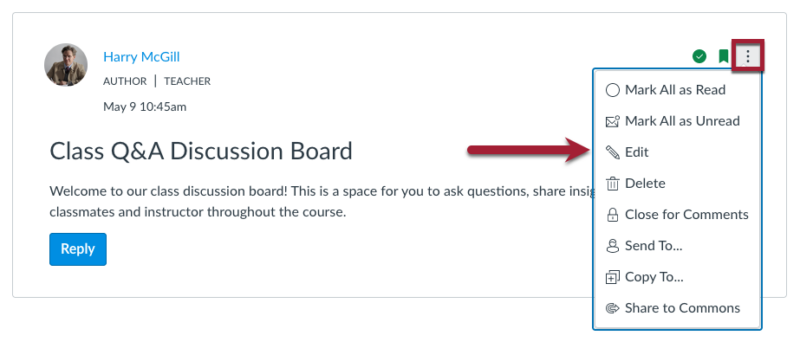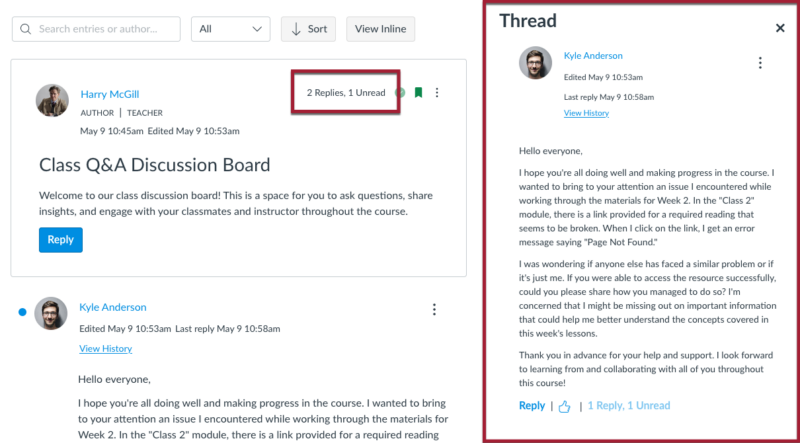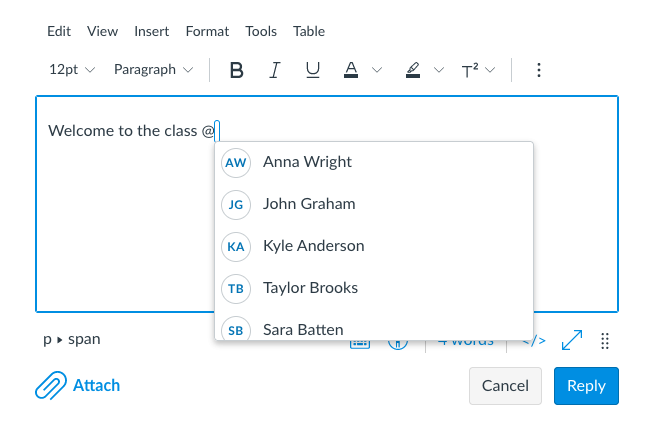Canvas Discussions are getting a fresh look and new features. From updated menus to more flexible ways to view and reply to posts, these changes are designed to help you and your students get more out of class discussions. Keep reading to learn what’s changing and how it can benefit your class discussions.
On May 20, 2024, the Discussions tool in Canvas is getting an updated user interface with new features and options. These enhancements are designed to make course discussions more intuitive, efficient, and accessible. The update will be automatically enabled for all MIT Sloan courses, so no action is required from teaching teams or students. All existing discussions will seamlessly transition to the updated UI, and the new functionality will be immediately available for use.
What’s New
The redesigned Discussions tool offers a number of enhancements:
Edit History for Posts
When students edit their discussion posts, teaching teams can view the version history.

The View History feature promotes accountability and can help you track the evolution of student thinking and contributions over time. Editing is enabled by default.
Anonymous Discussion
By default, student names and profile pictures are displayed when they post to discussions. However, you now have two options to enable anonymity:
- Partially anonymous: Students can choose to show or hide their name and profile pictures on their posts and replies. This allows each student to decide on the level of anonymity they prefer.
- Fully anonymous: All student names and profile pictures are automatically hidden on posts and replies. Only the content of student contributions is visible, without any identifying information.
Anonymity can help create a safe space for students to share ideas and feedback, express their opinions, and discuss sensitive topics without fear of judgment or bias. It may also encourage quieter students to participate more actively in online discussions.
Note: Teachers, TAs, Course Admins, and other teacher-like roles in the course will always be identified on their discussion posts.
Threaded Replies
All discussions are threaded and are limited to up to three levels of nesting:
- Initial post to topic
- Reply to initial post
- Reply to reply
Other key changes to threaded discussion replies include:
Streamlined Menu Options
Key actions like searching, filtering, sorting, adjusting reply views (split screen or inline), and expanding or collapsing threads are now conveniently located in the top Toolbar menu.

The controls for editing posts and marking threads and individual replies as read or unread have moved to the Options menu.

Enhanced Search
The Search feature, conveniently located at the top of each discussion, highlights matching text to make finding relevant posts and replies easier.
Sort Replies
Newest replies are displayed at the top of the thread by default. You can also sort replies from oldest to newest if preferred.
Flexible Viewing Options
You can view threaded replies either inline or in a split screen sidebar. The number of total and unread replies is also displayed.

Subscribe
You and your students can choose to manually subscribe to any discussion you want to follow. This feature allows you to receive notifications according to your notification preferences for discussions, ensuring you stay informed about the latest threaded replies. The ability to subscribe to discussions and receive notifications can help students stay engaged and informed, promoting a sense of connection and belonging in the course community.
Note: You are automatically subscribed to any discussions you reply to. This ensures you stay updated on any new posts or replies added to discussions you actively participate in.
Role Labels
To help students quickly distinguish between posts from their peers and the teaching team, discussions now display role labels for any posts made by a Teacher, TA, or Designer. Student posts, however, do not have a role label.

Role labels make it easier for students to locate and focus on posts from instructors and TAs. They can provide clarity and help establish teaching presence. It can also lend extra credibility and weight to teaching team responses.
Mentions
When composing a reply, you and your students can directly mention others in the course by using the @ symbol.
Simply type “@” and start entering the name of the person you want to address. A drop-down menu will appear, listing all available course participants that match your entry. Select the desired individual from the list to automatically insert a mention of their name. The mentioned user will receive a notification based on their notification preferences alerting them that they have been referenced in a discussion reply. This seamlessly draws their attention to the relevant post.

Using mentions is a great way to pose questions to instructors, request input from specific peers, or give credit to insightful contributions. It helps create a more dynamic, interactive, and personalized dialogue within the course community.
Quote Reply
You and your students can quote the original post when replying. This facilitates clearer communication by providing context and making it obvious which specific points are being addressed.
Report Inappropriate Messages
Students can privately flag any posts they feel are inappropriate, offensive, abusive, or otherwise violate course norms or policies. This feature can help maintain a respectful and inclusive learning environment by addressing any potential issues in a timely manner. Reporting is enabled by default.
When a student reports a reply, they must indicate why it is being reported. Reporting a reply cannot be undone.
Once reported, anyone with a “Teacher” role in the course will be notified based on their notification preferences so they can review the content in question and take appropriate action (edit or delete the reply).
See Canvas’s feature comparison chart for a summary of the key changes.
How-to Guides
For step-by-step instructions, refer to Canvas’s guides for:
How to Get Support
- Canvas provides 24/7 support to faculty, staff, TAs, and students. For immediate help, click the Help button in the Global Navigation Menu.
- If you still need assistance, submit a ticket and we’ll connect you with the resources and support you need right away.
See How to Get Help with Canvas for more details.










